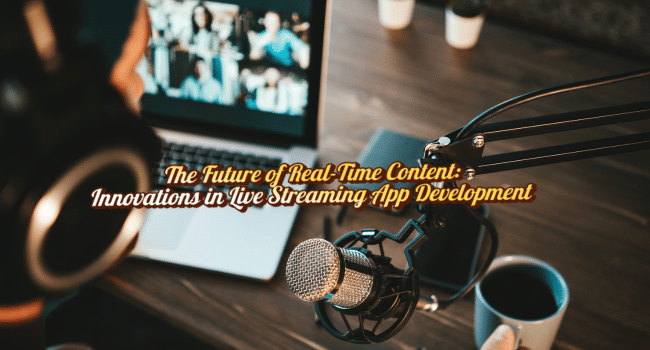Table of Contents
Introduction: Why Live Streaming Is the Future of Digital Interaction
In today’s hyper-connected world, real-time engagement is no longer optional—it’s the expectation. From social media influencers broadcasting daily updates to enterprises hosting virtual conferences, live streaming has emerged as one of the most powerful tools for communication. This surge in popularity is driven by the human need for immediacy, authenticity, and interaction.
Statistics show that viewers watch live content 3x longer than pre-recorded videos, and brands using live streaming report higher audience engagement rates. Whether it’s a concert, a product launch, or an educational workshop, live streaming offers something recorded media cannot: the ability to connect instantly and interactively.
At the core of this revolution is live streaming app development—the process of creating robust, scalable, and feature-rich platforms that bring real-time video experiences to users worldwide.
Understanding the Core Features of a Modern Live Streaming App
The success of a live streaming platform depends heavily on its feature set. In the competitive digital space, users expect flawless performance and immersive experiences. Essential features include:
- High-Quality Video and Audio Transmission: Adaptive bitrate streaming ensures smooth playback even on slower networks.
- Real-Time Chat and Interaction Tools: Polls, comments, Q&A, and emoji reactions keep audiences engaged.
- Content Moderation Tools: To maintain a safe environment, moderation features filter inappropriate content in real time.
- Cross-Platform Compatibility: Seamless viewing across mobile, desktop, and smart TVs expands audience reach.
- Replay and Archiving Options: Letting users watch missed broadcasts extends content value.
Building these features requires deep expertise in media streaming protocols, backend scalability, and UI/UX design tailored for live interactions.
The Role of Scalability and Performance in Live Streaming App Development
In live streaming, every second counts. Latency, buffering, or server overload can cause viewers to leave instantly. Scalability and performance optimization ensure that apps handle sudden traffic spikes—such as thousands of viewers joining a live sports stream—without crashing.
Key strategies include:
- Cloud-Based Infrastructure: Platforms like AWS or Azure offer flexible scaling during peak demand.
- CDN Integration: Content Delivery Networks reduce latency by distributing content closer to viewers.
- Load Balancing: Distributes traffic evenly to prevent server overload.
The best live streaming apps are engineered for both high performance and the ability to grow alongside their audience.
Emerging Technologies Shaping the Live Streaming Industry
The next wave of live streaming innovation is being fueled by advanced technologies, including:
- 5G Connectivity – Ultra-fast, low-latency networks are enabling 4K and even 8K live streams with minimal delay.
- Artificial Intelligence (AI) – Automating tasks like real-time transcription, content tagging, and personalized recommendations.
- Augmented Reality (AR) – Integrating AR filters and interactive elements for an immersive viewer experience.
- Blockchain – Securing transactions for pay-per-view content and enabling transparent creator compensation.
By incorporating these technologies, developers can build apps that not only meet current expectations but anticipate future demands.
Challenges Developers Face and How to Overcome Them
While the opportunities are vast, live streaming app developers face unique challenges:
- Bandwidth Limitations: Optimizing streams for different internet speeds is critical to prevent buffering.
- Content Security: DRM (Digital Rights Management) and encryption help protect intellectual property.
- Latency Issues: Implementing low-latency protocols like WebRTC can minimize delays.
- Monetization Models: Balancing ad integration, subscription models, and pay-per-view without hurting the user experience.
Overcoming these challenges requires both technical expertise and a strong understanding of user behavior.
How Businesses Benefit from Custom Live Streaming Solutions

Live streaming is no longer just for entertainment—it’s a business growth tool across industries:
- E-Commerce: Retailers host live shopping events, allowing customers to purchase products instantly.
- Education: Schools and universities provide remote learning through interactive video sessions.
- Corporate: Companies host webinars, training sessions, and virtual conferences to connect globally.
- Healthcare: Doctors offer live telemedicine consultations, expanding access to care.
Custom live streaming app development enables businesses to tailor solutions to their unique needs, ensuring better engagement and ROI.
Case Studies: Real-World Applications of Live Streaming in Various Industries
- Fitness Industry: A global fitness brand launched a live workout app that integrates music synchronization, real-time chat, and on-demand replays, increasing customer retention by 40%.
- Sports Broadcasting: A sports league developed a mobile-first streaming platform with low-latency delivery, enabling fans worldwide to watch matches with minimal delay.
- Education Sector: A language learning platform integrated interactive quizzes during live sessions, boosting user engagement by 55%.
These examples highlight how strategic live streaming solutions can transform industries.
Integrating AI and AR for Next-Level Live Streaming Experiences
AI and AR are redefining how viewers interact with live streams:
- AI-Powered Recommendations: Suggesting relevant live events based on viewing history.
- Real-Time Captioning: Making content accessible to global audiences.
- AR Filters and Overlays: Popular in gaming and entertainment, these add visual flair to streams.
- Interactive 3D Environments: Allowing viewers to explore a virtual stage or venue.
These integrations create a richer, more personalized experience that keeps audiences coming back.
Security and Privacy Considerations in Live Streaming Platforms
Security is a critical concern in live streaming, particularly for events involving sensitive information or monetized content. Developers implement:
- End-to-End Encryption: Protecting data during transmission.
- Access Control: Restricting streams to authorized users.
- Watermarking: Preventing content piracy.
- Secure Payment Gateways: Ensuring safe transactions for pay-per-view events.
Strong security builds user trust, which is essential for long-term platform success.
Conclusion: Preparing for the Next Wave of Live Streaming Innovation
Live streaming has evolved from a niche entertainment tool to a mainstream business, educational, and social communication channel. As technology advances—with 5G, AI, AR, and blockchain leading the way—opportunities for innovation are endless.
For businesses and creators alike, investing in live streaming app development is not just about keeping up with the times—it’s about leading the digital conversation. The future belongs to those who can deliver high-quality, interactive, and secure live experiences that engage audiences in real time.
